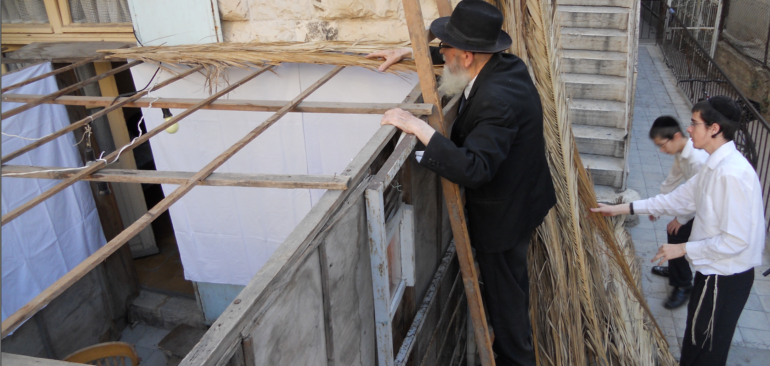
How Can I Get the Most Air Circulation in My Sukkah This Year?
Dear Jew in the City-
How can I get the most air circulation in my sukkah this year? We are considering having company since outdoor socialization seems safer now. What’s the least amount of material my sukkah can have for maximum airflow and still be kosher?
Thank you,
C.M.
Dear C.M.-
Okay, first things first. I’m going to disagree with you as far as the advisability of having guests in your succah. Just look at the spike in the number of Covid cases in Jewish communities following Rosh Hashana. Not everyone is taking the social distancing as seriously as they should and we’re not out of the woods yet.
As I write this, I haven’t yet seen anything about Succos from the Department of Health or from rabbinic authorities but the British government has laid out some guidelines. These include not inviting guests, not sharing food between households, not visiting one another’s succah and not using one another’s arba minim. As far as Simchas Torah, which follows immediately on the heels of Succos, the British government advises that if dancing must take place (which – who are we kidding? – it will), only a limited number of people should hold the Torahs.
As noted, I haven’t yet seen any local guidelines regarding these matters but these seem to be appropriate courses of action, especially in light of the Covid cases that followed school openings, Rosh Hashana and other larger gatherings.
That being said, I will happily address how to increase airflow in your succah, which one may find desirable with or without guests.
First off, a succah doesn’t have to have four full walls. It doesn’t even need three full walls. All a succah requires is two-and-a-fraction walls (Talmud Succah 6b-7a). While a two-and-a-fraction-walled succah is not optimum in practice, it is kosher.
There’s an interesting allusion to this halacha in the word “succah,” which is spelled סכה in Hebrew. The letter samech is closed on all sides, the kaf is closed on three sides and the hei is closed on two-and-a-fraction sides, reflecting the kosher configurations of a succah. Please note, however, that the Rema on OC 630:5 says that because of our lack of proficiency, our practice is not to rely on partial walls; he cites an opinion that it’s better to have a succah of three full walls than one of four partial walls. Nevertheless, even a succah of only three walls would still have pretty impressive airflow.
Another thing to consider is the halachic concept of lavud (Eiruvin 16a-b). Lavud is a principle stating that a gap smaller than three handbreadths (about nine or ten inches) is considered as if it were closed up. Accordingly, a succah can be made up of horizontal or vertical strips with gaps in between the rows. This would certainly maximize airflow. If one wishes to rely on lavud in constructing one’s succah and is not proficient in the details, one should consult his or her own rabbi for guidance.
Finally, a screen (by which I mean a window screen made of horizontal and vertical wires) is a perfectly valid wall in halacha. (You can’t walk through it, can you? No. Because it’s a wall, albeit one you can see through.) Accordingly, one’s entire succah could be made of screen material purchased from Lowe’s or the Home Depot. (Not sponsored content!)
It should be noted that, in order to be kosher, a succah’s walls may not sway in a regular breeze (as opposed to gusts, squalls or gales) so, regardless of the material one chooses to use for succah walls, it must be fastened tightly (OC 630:10).
Wanting to increase airflow is great but there are other considerations, such as having a modicum of privacy. Eating in an outdoor hut, whose roof is composed of sticks, furring strips or a reed mat, and which has at least a door and probably also windows, you’ll probably have all the fresh air you need for your own family. If that feels insufficient for guests during the pandemic, it might be advisable to delay having guests for the duration rather than knocking out a wall.
Sincerely,
Rabbi Jack Abramowitz
Educational Correspondent
Follow Ask Rabbi Jack on YouTube
If you found this content meaningful and want to help further our mission through our Keter, Makom, and Tikun branches, please consider becoming a Change Maker today.







